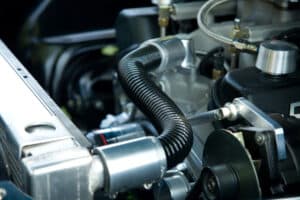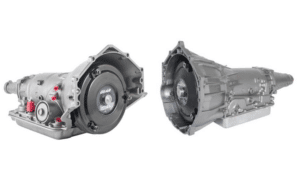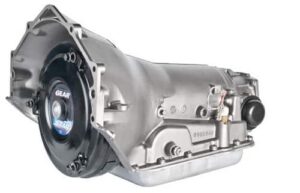Effective cooling is essential to maintaining the performance and lifespan of older GM transmissions like the 4L70E, 4L75E, and 4L65E. Low or contaminated transmission fluid, improper transmission maintenance, and excessive idling are some common causes for an overheated transmission. Overheating can damage vital components, leading to costly repairs.
Transmission failure is always an expensive and frustrating problem, especially in GM models known for power but prone to heat issues, which can lead to warped rubber seals, worn out pistols, and burnt clutch packs.
An overheated transmission can lead to problems ranging from slipping gears to total transmission failure. With a proper cooling system and preventive care, you can prevent overheating and extend the life of your 4L70E, 4L75E, or 4L65E transmission.
Why Proper Cooling is Essential for GM Transmissions
Keeping your transmission cool isn’t just about maintaining performance; it’s about preventing costly damage that can compromise your entire vehicle. Let’s take a look at some of the risks associated with overheating and how cooling protects GM transmissions like the 4L70E, 4L75E, and 4L65E.
The Impact of Heat on Transmission Longevity
Heat is one of the main enemies of automatic transmissions, especially GM’s high-performance models. While these transmissions are designed to take a beating – especially models built with hardened materials, like the 4L65E – high-performance driving from heavy towing to racing can greatly impact transmission longevity and cooling capacity.
As temperatures rise – whether due to damage to the transmission cooler, driving style, or external factors – so does the risk of worn components, fluid breakdown, and damage to sensitive parts.
Why GM Transmissions are Susceptible to Overheating
Models like the 4L70E, 4L75E, and 4L65E are powerful but work harder under high-stress conditions, especially when built into high-performance project cars or heavy-duty vehicles. Towing, off-roading, drag racing, and city driving can all put a strain on these transmissions, making them more vulnerable to overheating and damage.
How to Prevent Overheating in Automatic Transmissions
Preventive cooling measures are essential for protecting your transmission from overheating. Here are key tips to keep your transmission’s temperature in check and prevent damage, especially in demanding conditions.
Installing a Dedicated Transmission Cooler
A transmission cooler is one of the best investments you can make. It works by dispersing heat more effectively than your transmission’s built-in cooler, lowering fluid temperatures and helping your transmission perform better over time. Transmission coolers are usually mounted to the radiator, further helping your car cool your transmission lines and prevent heat damage. Rather than routing to and from the radiator, transmission coolers take the output fluid from the radiator, cool it further, then route it back to the transmission.
Using High-Quality Transmission Fluid
The right transmission fluid can help reduce friction and dissipate heat. Better quality or synthetic transmission fluids perform well under high temperatures, helping you keep your GM transmission cool even when the vehicle is under load. Like with motor oils, transmission fluid compatibility is important. Be sure you’re picking a high-performance fluid that matches your specific transmission, whether it’s a 4L75E, 4L65E, or a 4L70E.
Regular Fluid Checks and Maintenance
Consistent fluid level checks and changes are essential for transmission health. Low or degraded transmission fluid leads to more friction, which increases temperature and wears out parts. Like with your engine, it’s best to stick to a maintenance schedule to ensure your transmission fluid stays clean and at optimal levels.
Preventative Care for Transmission Health
A proactive maintenance approach helps keep your GM transmission performing reliably. With routine care and monitoring, you can avoid many of the issues that lead to overheating and premature failure. Here are some basic tips:
Routine Inspections and Fluid Flushes
Regular inspections of transmission lines, fluid filters, and flushes are essential. Changing your fluids and checking your cooler isn’t always enough. Dirt, debris, and corrosion can block or erode your fluid lines, causing coolant leaks. Regularly inspect your transmission for signs of transmission fluid leaks, such as a buildup of oil and debris alongside the bottom of the transmission, often around a nut. Sometimes, something as simple as a missing or broken washer can cause thousands of dollars of damage to an otherwise perfectly functional transmission.
Driving Habits that Preserve Transmission Health
Driving style has a huge impact on transmission longevity. This is more so a cause for caution – if you need a heavy-duty tow truck, then you’re not going to stop towing heavy loads because of a transmission issue. You’re going to look for another transmission. But if your driving habits or requirements for your vehicle regularly test your engine and transmission, be sure to check your engine and transmission health more frequently.
Monitoring Transmission Temperature
Install an added temperature gauge to keep an eye on your transmission’s operating temperature. Modern sensors and electronic controllers can help you keep a better eye on your transmission health, while further improving fuel economy and efficiency on an otherwise old transmission. Staying within the recommended range allows you to spot rising heat issues early, giving you time to act before serious damage occurs.
Common Signs of Transmission Overheating or Failure
Knowing when trouble has come knocking in GM transmissions like the 4L70E, 4L75E, and 4L65E can help you take corrective steps before a full breakdown occurs, saving you thousands of dollars. Keep an eye out for:
Delayed Shifting or Slipping Gears
When a transmission is struggling, shifts become rough or delayed. Slipping gears and inconsistent shifting are common indicators that your transmission is overheating or experiencing other issues, from fluid leaks to stripped gears.
Strange Noises During Shifting
Grinding, clunking, or whining noises when your transmission shifts can signal overheating, solenoid issues, or worn components. This may mean that the transmission fluid isn’t effectively reducing friction, leading to excessive wear on parts.
Burning Smell or Dark Fluid
A burning smell or darkened transmission fluid is a clear sign of overheating. Burnt fluid loses its protective qualities, leading to more heat buildup and increased risk of damage, essentially making matters much worse.
Conclusion
Proper cooling is essential for the health of all transmissions, especially in GM models like the 4L70E, 4L75E, and 4L65E that are often used in high-performance and towing applications. Regular maintenance, proactive cooling measures, keeping an eye on your transmission temperature, and recognizing the signs of overheating can help you avoid costly repairs and keep your vehicle running smoothly for many more years to come.


